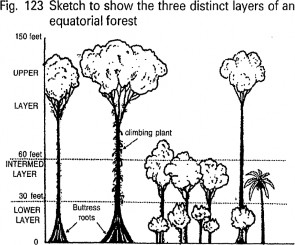Climatic Conditions
Temperature: The most outstanding feature of the equatorial climate is its great uniformity of temperature throughout the year. The mean monthly temperatures are always around 27°C with very little variation. There is no winter. Cloudiness and heavy precipitation moderates the daily temperature, so that even at the equator itself, the climate is not unbearable. The diurnal range of temperature is small, and so is the annual range.
Precipitation: Precipitation is heavy, between 60 inches and 100 inches, and well distributed throughout the year. There is no month without rain and a distinct dry season like those of the Savannah or the Tropical Monsoon Climates, is absent. Due to the great heat in the equatorial belt, mornings are bright, and sunny. There is much evaporation and convectional air currents are set up, followed by heavy downpours.

Natural Vegetation: It supports a luxuriant type of vegetation – the tropical rain forest. Amazon tropical rain forest is known as Selvas. It comprises a multitude of evergreen trees that yield tropical hardwood, e.g. mahogany, ebony, greenheart, cabinet wood. Lianas, epiphytic and parasitic plants are also found. Trees of single species are very scarce in such vegetation.
Life and Development in the Equatorial Regions: The equatorial regions are generally sparsely populated. In the forests most primitive people live as hunters and
collectors and the more advanced ones practise shifting cultivation. In the Amazon basin, the Indian tribes collect wild rubber, in the Congo Basin the Pygmies gather nuts and in the jungles of Malaysia the Orang Asli make all sorts of cane products and sell them to people in villages and towns. In the clearings for shifting cultivation, crops like manioc (tapioca), yams, maize, bananas and groundnuts are grown.
